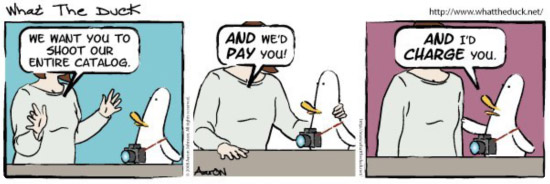There are three major sections to an estimate for a job you are bidding on for a client.
1. Your costs
2. The price the client pays
3. Your selling of yourself and why you are the best person for the job
Your Costs
There are two sections to every job when it comes to expenses.
1. Ongoing expenses spread across all jobs, which we refer to as the “Cost of Doing Business.” This gets broken down even more into
a. Living Expenses
b. Business Expenses2. Job costs associated to the project. If you have prints, travel expenses, and other things that you would not have as expenses unless you were doing this job.
Your costs are not what you quote to the client. This is what you use to help you know what you must clear for a profit. Take this information and then figure out what you need to charge.
The Price the Client Pays
 |
| http://www.whattheduck.net |
1. The Price
If you are selling to the public prints they put on their walls from portrait sessions you may have a variety of packages that include the shooting fees and maybe a starting number of prints.
You may shoot weddings and then have similar print costs like the portrait photographer, but also have more prints and binders to create books for the couple.
When you shoot for corporate or advertising you have shooting fees plus usage fees. These usage fees are based on where and for how long they plan to use a photograph.
2. The Package
Typically you are going to offer more than one solution and hope that you can up sell the client. Most often you will have 3 to 4 prices.
A) Rock Bottom Price
B) Low End Price
C) Medium Price
D) High End Price
Your Sales Pitch
This is the area I see the weakest for most photographers. They quote a price as a take it or leave it price. Those who understand how to sell often do not mention prices until they have sold the client on their services.
The key is to first find out what they need and learn how to meet the need and even exceed it. Once you have done this selling is quite easy.
If you are just pitching packages and not understanding how they plan to use the images you are unable to show how you are helping them.
Lets break this down into bite size steps:
1. Establish the need. You can ask directly and sometimes they know, but more than often you are going to need to explore with the client and understand them and or their business to be able to establish what they are trying to accomplish.
2. Word all of your pitches to address the need and show them how by picking a certain product you are offering they will accomplish even more.
3. Give them options. Too often photographers do not put themselves in a very good negotiating position. Try your best to always think of three prices they could choose to meet their needs. Maybe on the bottom price they only get the digital images. Next level they get prints and on the top end you even provide online galleries. Be creative think of ways that you can give them a choice.
Learn to say yes!
When a client asks for something that you are uncomfortable with, unless it is unethical price it so you can either bring on help to make it happen or the money is enough to make it worthwhile. When you are saying to the client I would love to help you and here is how much it is to do that for you then if the price is too high, they said no and not you.
Too many photographers for example say no to not selling their copyright. Just put the price high enough that it is worth it. Surely you would like to retire tomorrow for the right price today.
Put yourself in the clients perspective
While you may have done everything just right and it makes sense to you, ask a friend who knows nothing about photography to hear your proposal. Ask them to let you know if anything doesn’t make sense to them. Ask them if it feels like you are excited about serving them.
If people are only shopping price rarely will you get the job. If they are shopping for solving their problem and feeling taken care of by a photographer—you most likely are in the running using these principles.


